Nicnon S 7x50
| Die Nicnon S ist eine Kombination eines 7x50 Porro-1-Monokulars und einer Kleinbild-Kamera (Ricoh Auto Half E). Das Monokular mit zweifach verschraubten Deckel in Rauten- bzw. Parellogrammform hat ein Gehäuse mit Kunstlederummantelung, eingegossener Trageriemenöse und einem Standard-Stativgewinde. Die Metallteile sind schwarz lackiert. Das linksseitige Okular ist aus Metall und hat eine Dioptrieneinstellung von +2 bis -4 in 1er-Schritten beschriftet. Die Nullmarke und der Refernzstrich an der Okularhülse ist rot gekennzeichnet. Zum genauen Anvisieren gibt es eine Fadenkreuzstrichplatte. Das Objektiv ist ein Kameraobjektiv mit einer Irisblende und Einstellungen "F = 3,5-11" (weiß) sowie "T = 9-32" (gelb). Am Objektivtubus ist dafür ein roter Referenzpunkt und eine rote Linie als Referenz für den äußeren Fokussierungteil des Objektiv in Meter (weiß: 6-100 ∞) und Fuß (grün: 18-300 ∞). Dieser Fokussierungsteil hat 9 geriffelte Griffflächen. Es gibt einen aufschraubbaren Metallschutzdeckel für das 58mm Filtergewinde. Das Objektiv ist im Linsenring mit "Nicnon-S" sowie "f=165 l:3,5 No. 200246" gekennzeichnet. Der obere Deckel des Monokulars ist mit "Nicnon — S —", "Field 300ft at 1000 Yard 7x50" und der Seriennummer "No. 451215" beschriftet. Der untere Deckel ist mit J-B116 markiert, der für "Nichiryo Co. Ltd., Tokio" steht. Die Firma Nichiryo International Corp. Ltd. wird auch auf dem silberen Aufkleber am Kameradeckel als Hersteller genannt. Die Nicnon S wurde 1968 herausgebracht, also ca. 10 Jahre nach der Entwicklung der Möller Cambinox. |
The Nicnon S is a combination of a 7x50 Porro 1 monocular and a small film camera (Ricoh Auto Half E). The monocular with cover plates in a diamond shape and fixed by two screws has a housing with a synthetic leather covering, a cast-in strap lug and a standard tripod thread. The metal parts are lacquere black. The left-hand sided eyepice is made of metal and comes with a dioptre scale from +2 to -4 while every division line is marked with numbers. The zero mark and the reference line on the eyepiece are paitned red. There is a cross-hairs reticle for exact sighting. The objective is a camera lens with an iris diaphragm and marked with "F = 3,5-11" (white) as well as "T = 9-32" (yellow) for adjustment. The scale division correspond to a red dot on the objective tube, and a red line referring to the outer focusing adjustment piece. The focsuing scale is in metres (white: 6-100 ∞) and feet (green: 18-300 ∞). This focusing piece has 9 knurled surfaces for better gripping. It also comes with a screw-on metal protection cap fittin to the 58mm filter thread. The ojective is imscribed "Nicnon-S" and "f=165 l:3,5 No. 200246" on the inner lens ring. The top cover of the monocular is marked "Nicnon — S —", "Field 300ft at 1000 Yard 7x50" and with the serial nubmer "No. 451215". The bottom cover ist marked J-B116 which stands for "Nichiryo Co. Ltd., Tokyo". The Nichiryo International Corp. Ltd. as a maker is also printed on a silvery label on the camera cover. The Nicnon S was first issued in 1968, which is about 10 years after the development of the Möller Cambinox. |
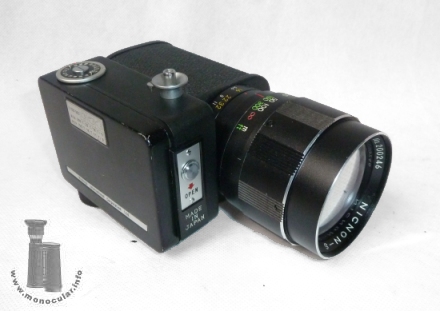
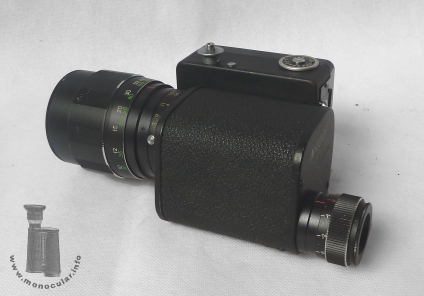
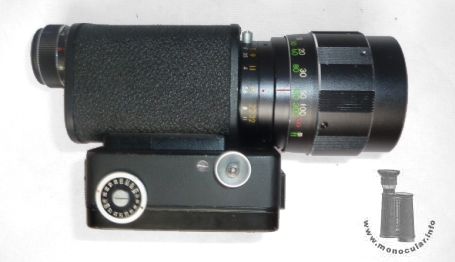
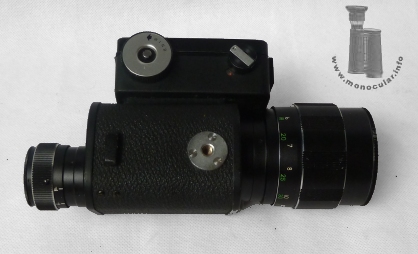
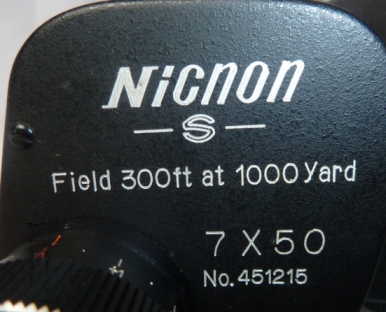
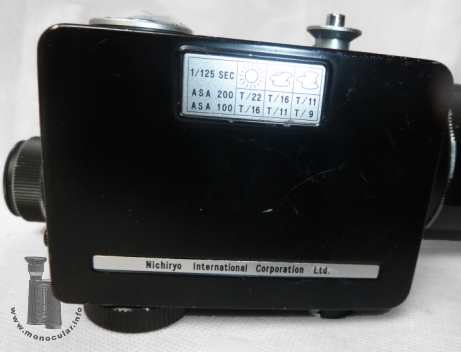
| Die Kamera ist an der rechten Monokulargehäuseseite mit einem Sockel montiert. Oben am Kameragehäuse gibt es einen Auslöser mit Gewinde für einen Kabelauslöser. Ein Stellrad ermöglicht das Merken der genutzten Filmempfindlichkeit (ASA). An der Unterseite ist die Filmtransportkurbel und Spulknopf. Die rechte Seite (im Monokularsystem nach vorne gerichtet) weist den Schiebeknopf zum Öffnen des Kameradeckels auf sowie auf einem Plastikrahmen darum die Beschriftung "Made in Japan". Die Einstellung der Verschlusszeiten (60 125 205) befindet sich auf der linken Kameraseite bzw. hinten. Außer der Firmenbezeichnung ist der Deckel mit einem Aufkleber zur Blendenzeit (+ Wettersymbole) bei 1/125 sec. Belichtung und bei ASA 100 oder 200 versehen. Das anvisierte Bild wird per Strahlenteiler zur Seite in die Kamera gelenkt und beim Auslösen der Verschluss zum Film geöffnet. S.a. hier "Nichiryo Nicnon-S" (s.a. binokulare Modelle Nicnon TF-S - s letztes Foto - bzw. fast identisch Ricoh Teleca 240: Webseite 1 Webseite 2. |
The camera is attached with a base to the right side of the monocular body. On top of the camera hosuing is a trigger with a thread for a cable release. A thumbwheel allows to note the film sensitivity (ASA). At the bottom there is a film transport crank and a reel knob. The righ-hand side (i.e. the side pointing forward referring to the monocular) comes with a sliding button to open the camera body cover. There is also a "Made in Japan" marking on the plstic frame around it. The shutter speed adjustment (60 125 205) is on the left-hand side of the camera body or backwards respectively. Apart from the company's name the back cover has another silvery sticker gibing the aperure times (+ weather symbols) for 1/125 sec. exposure and for ASA 100 or 200. The viewed iamge is deflected siodeways into the camera by means of a beam splitter. So, when triggering the shutter of the camera is opened and lets in the light Also cf. here "Nichiryo Nicnon-S" (also see binocular models: the Nicnon TF-S - see last picutre - or almost identical the Ricoh Teleca 240: website 1 website 2. |
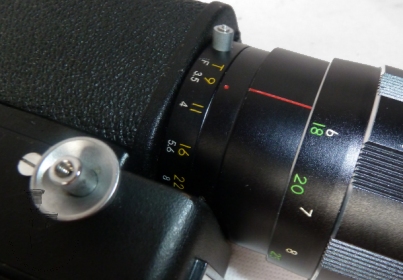
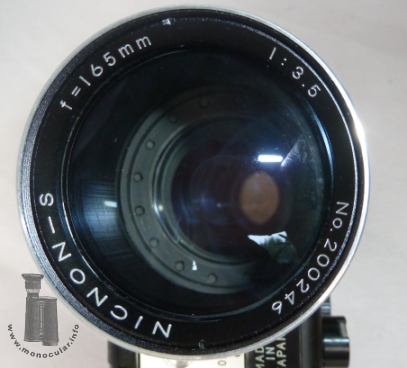
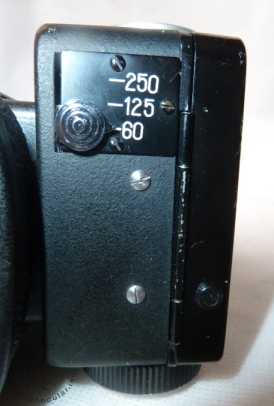
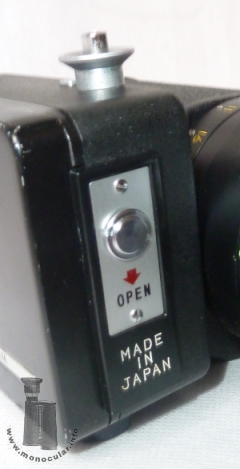
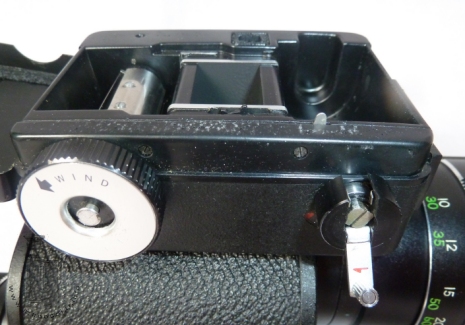
| Die Nicnon S wiegt 1086g. Es ist 188-202mm lang je nach Fokussierung und Dioptrieneisntellung. Das 82mm lange Gehäuse ist 68x62mm breit. Das Okularstück ist 33mm, der Fokussierungsring 36mm und der obere Augenmuschelteil 33mm im Durchmesser. Das Objektiv misst bei der Blendeinstellung 54mm, am Fokussierungsteil 64mm und bei der Linsenfassung 61mm im Durchmesser. Die Kamera ist 65x94x37mm groß. | The Nicnon S weighs 1086g. It is 188-202mm long depending on focusing and dioptre adjustment. The 82mm long hosuing measures 68x62mm. The eyepiece is 33mm, the focuisng ring 36mm and the top part of the eyecup 33mm in diameter. The photo-lens is 54mm in diameterat the aperture adjustment ring, 64mm in diameter at the focusing ring, and 61mm in diameter at the objective lens frame. Die Kamera ist 65x94x37mm groß |
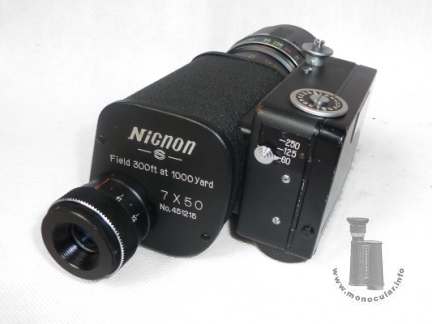
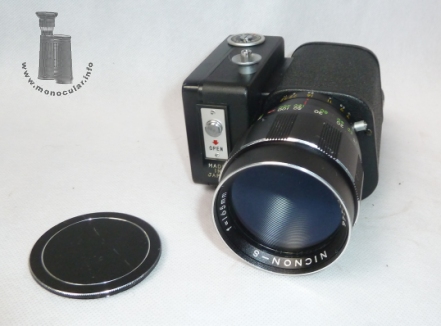
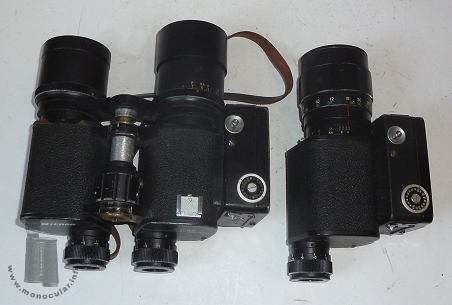
Fotos: Zeun

